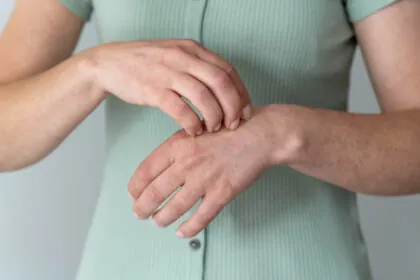Osteoarthritis, often abbreviated as OA, is a common joint disorder that primarily affects the cartilage, which is the slippery tissue that covers the ends of bones in a joint.
It is one of the most prevalent forms of arthritis and is typically associated with aging, although it can also result from joint injury or obesity.
In a healthy joint, cartilage provides a smooth, gliding surface for the bones to move against each other.
The cartilage gradually breaks down and becomes less effective, leading to several characteristic symptoms and issues
Causes
It is a complex condition, and its exact causes are not fully understood.
However, several factors are believed to contribute to its development.
These factors can vary from person to person, and in many cases, it’s likely a combination of multiple factors that leads to the development of the condition.
Some of the key factors thought to be involved in the development include:
Aging
The risk increases with age. As people get older, the cartilage in their joints may naturally break down and become less resilient.
Genetics
There is evidence to suggest that genetics can play an important.
If you have a family history of the condition, you may be at a higher risk.
Joint injuries or trauma
A history of joint injuries, such as a previous fracture, ligament damage, or repetitive stress on a joint, can increase the likelihood of development the disease.
Mechanical stresses
Overuse and excessive mechanical stresses on a joint can contribute to the development of osteoarthritis.
This can be the result of occupations or activities that place repetitive or excessive strain on specific joints.
Obesity
Carrying excess body weight places additional stress on weight-bearing joints, such as the knees and hips.
This can accelerate the wear and tear on joint cartilage and increase the risk of osteoarthritis.
Joint misalignment
If a joint is not properly aligned or if there are structural abnormalities in the joint, it can increase the risk of osteoarthritis in that joint.
Hormonal factors
Some research suggests that hormonal changes, such as those that occur during menopause, may contribute to the development of osteoarthritis in women.
Other medical conditions
Certain medical conditions, such as rheumatoid arthritis, gout, and metabolic disorders, can increase the risk of osteoarthritis.
It’s important to note that while these factors are associated with an increased risk of osteoarthritis, not everyone with these risk factors will develop the condition.
Osteoarthritis is a complex interplay of genetic, environmental, and lifestyle factors, and its development can vary from person to person.
Symptoms
The symptoms of osteoarthritis can vary depending on the joint or joints affected and the severity of the condition.
Common symptoms of osteoarthritis may include:
Joint pain
Osteoarthritis typically causes pain in the affected joint.
The pain is often described as a deep, aching discomfort. It can be aggravated by movement or weight-bearing activities and may improve with rest.
Stiffness
Joints affected by osteoarthritis can become stiff, especially after periods of inactivity.
This stiffness often eases with gentle movement.
Reduced range of motion
As the condition progresses, you may notice a decreased range of motion in the affected joint.
It may become more challenging to fully bend, straighten, or rotate the joint.
Swelling
Some people with osteoarthritis may experience mild to moderate swelling in the affected joint, which can be due to inflammation or the accumulation of fluid.
Joint instability
In advanced cases, osteoarthritis can lead to joint instability, making it feel like the joint is giving way or being less reliable for weight-bearing activities.
Joint deformities
Over time, osteoarthritis can lead to joint deformities, especially in the fingers and knees.
This can result in noticeable bumps or bony enlargements, known as bone spurs or osteophytes, around the affected joint.
Crepitus
Osteoarthritis can cause a crackling or grating sensation known as crepitus when you move the affected joint.
Muscle weakness
The muscles surrounding the affected joint may weaken as a result of pain and reduced use, which can further limit joint function.
It’s important to note that the severity and progression of osteoarthritis can vary widely from person to person.
Some individuals may experience only mild discomfort, while others may have significant pain and disability.
Osteoarthritis can affect any joint, but it most commonly occurs in weight-bearing joints like the knees, hips, and spine, as well as the hands, particularly the base of the thumb and the end joints of the fingers.
Treatments
The treatment of osteoarthritis typically focuses on managing the symptoms, reducing pain, and improving joint function.
The choice of treatment can vary depending on the severity of the condition and the affected joints. Here are three common treatments for osteoarthritis:
Lifestyle and Self-Care Strategies
- Weight management:
Maintaining a healthy weight is crucial, especially for weight-bearing joints like the knees and hips.
Excess body weight can increase the stress on these joints, leading to more pain and faster joint deterioration.
Weight loss through diet and exercise can help alleviate symptoms and slow down the progression of osteoarthritis. - Exercise:
Regular, low-impact exercise, such as walking, swimming, or cycling, can help strengthen the muscles around the affected joint, improve joint flexibility, and reduce pain.
Physical therapy programs may be recommended to develop an exercise regimen tailored to your specific needs. - Assistive devices:
Devices like braces, orthotics, or canes can provide support and reduce joint stress.
In some cases, custom-fitted orthopedic devices may be prescribed to help improve joint alignment and function. - Joint protection techniques:
Learning how to perform daily tasks with minimal stress on the affected joint can be beneficial.
Occupational therapists can teach you techniques to protect your joints while performing activities of daily living. - Hot and cold therapy:
The application of heat or cold to the affected joint can provide temporary relief from pain and stiffness.
Heat can help relax and soothe the joint, while cold therapy can reduce inflammation.
Medications
- Pain relievers:
Over-the-counter pain relievers, such as acetaminophen, and nonsteroidal anti-inflammatory drugs (NSAIDs), like ibuprofen, can help manage pain and reduce inflammation.
Prescription-strength NSAIDs may be recommended for more severe symptoms.
However, long-term use of NSAIDs should be monitored by a healthcare professional due to potential side effects. - Topical analgesics:
Creams, gels, or patches containing medications like capsaicin or NSAIDs can be applied directly to the skin over the painful joint to provide localized pain relief. - Intra-articular injections:
In some cases, healthcare providers may recommend injecting corticosteroids or hyaluronic acid directly into the affected joint to reduce pain and inflammation.
These injections can provide short-term relief and may be repeated periodically.
Surgical Interventions
- Joint replacement surgery:
For individuals with severe osteoarthritis and significant joint damage, joint replacement surgery may be an option.
This involves replacing the damaged joint with a prosthetic joint, such as in hip or knee replacement surgeries.
Joint replacement surgery can significantly improve joint function and alleviate pain. - Osteotomy:
This surgical procedure involves repositioning the bones around the affected joint to shift the load-bearing forces away from the damaged area.
It is typically performed in younger individuals with specific joint deformities. - Arthroscopy:
In some cases, minimally invasive arthroscopic surgery may be used to remove loose pieces of cartilage or bone, smooth the joint surfaces, or repair damaged tissues within the joint.
The choice of treatment will depend on the specific needs and circumstances of the individual with osteoarthritis
Tips to prevent Osteoarthritis
While it’s not always possible to completely prevent osteoarthritis, there are several lifestyle changes and strategies that can help reduce the risk of developing the condition or slow its progression, particularly if you are at higher risk due to factors like genetics or previous joint injuries.
Here are some tips to help prevent osteoarthritis:
Maintain a Healthy Weight
Maintaining a healthy weight is a crucial factor in preventing osteoarthritis and reducing the risk of its development for several reasons:
- Reduced Joint Stress:
Excess body weight places added stress on the weight-bearing joints, such as the knees and hips. When you are overweight or obese, the joints have to support a greater load than they were designed for. This added stress can accelerate the wear and tear of the joint cartilage, increasing the risk of osteoarthritis. - Lower Inflammation:
Adipose (fat) tissue is not just a passive reservoir for excess calories; it also secretes inflammatory chemicals known as cytokines. Excess body fat can lead to chronic low-level inflammation, which is a risk factor for the development and progression of osteoarthritis. - Improved Joint Mechanics:
Maintaining a healthy weight can help with better joint alignment and mechanics. When you have a healthy body weight, your joints are less likely to be subjected to irregular or excessive forces that can lead to joint damage. - Reduced Wear and Tear:
A healthy weight can decrease the mechanical wear and tear on your joints during daily activities and exercise.
This, in turn, can slow down the degeneration of joint cartilage and reduce the risk of osteoarthritis. - Improved Pain Management:
If you already have osteoarthritis, maintaining a healthy weight can help manage symptoms more effectively.
Excess weight can exacerbate pain and stiffness in the affected joints, so weight loss can alleviate these symptoms and improve your overall quality of life.
It’s important to note that even a modest reduction in body weight can have a positive impact on joint health and osteoarthritis prevention.
Losing just a small percentage of your body weight can significantly reduce the risk and severity of the condition.
Stay Physically Active
Staying physically active is an important strategy for preventing osteoarthritis and maintaining joint health. Regular exercise offers several benefits that can help reduce the risk of developing osteoarthritis and slow its progression if you already have the condition:
- Maintaining Joint Flexibility:
Regular physical activity helps keep your joints flexible and mobile. It can prevent joint stiffness, which is often a precursor to osteoarthritis. - Strengthening Muscles:
Exercise helps strengthen the muscles around your joints. Strong muscles provide better support and stability to the joints, reducing the risk of injury and the development of osteoarthritis. - Weight Management:
Exercise can aid in weight management. Maintaining a healthy weight is crucial in preventing osteoarthritis, especially in weight-bearing joints like the knees and hips. Regular physical activity can help you burn calories and reduce excess body weight. - Enhanced Blood Flow:
Exercise improves blood circulation, which can promote the delivery of nutrients and oxygen to joint tissues. This helps keep the cartilage and other joint structures healthy. - Improved Joint Lubrication:
Physical activity can stimulate the production of synovial fluid, which lubricates the joints. This lubrication helps reduce friction and wear on the joint surfaces. - Preventing Cartilage Breakdown:
Weight-bearing exercises can stimulate the production of compounds that help protect and repair cartilage. - Enhancing Joint Stability:
Activities that involve balance and coordination can improve joint stability, reducing the risk of falls and injuries that may lead to osteoarthritis.
It’s important to choose the right type of exercise and incorporate it into your routine safely, especially if you have a higher risk of osteoarthritis or if you already have the condition.
Avoid Joint Injuries
Avoiding joint injuries is an important aspect of preventing osteoarthritis because injuries to the joints can significantly increase the risk of developing the condition. Joint injuries can damage the cartilage, alter joint mechanics, and lead to long-term issues that contribute to the development of osteoarthritis. Here’s how avoiding joint injuries can help prevent osteoarthritis:
- Preservation of Cartilage:
Joint injuries can directly damage the cartilage that covers the ends of bones in a joint. Cartilage acts as a protective cushion, allowing smooth and pain-free movement. When cartilage is damaged or worn away due to injuries, it can lead to the early onset of osteoarthritis. - Maintenance of Joint Mechanics:
Joint injuries can disrupt the normal mechanics and alignment of the affected joint. This can result in irregular stress and wear on the joint surfaces, increasing the risk of osteoarthritis over time. Proper joint mechanics are essential for preventing excessive strain on the joint. - Reduced Inflammation:
Joint injuries often trigger an inflammatory response in the affected area. Chronic inflammation is a known risk factor for the development and progression of osteoarthritis. By avoiding injuries, you can help prevent the initiation of this inflammatory process. - Prevention of Post-Traumatic Osteoarthritis:
Injuries that do not heal properly or cause lasting joint damage can lead to post-traumatic osteoarthritis, a specific type of osteoarthritis that develops as a result of a previous joint injury. Avoiding these injuries can help prevent the onset of this condition.
Eat a Balanced Diet
Eating a balanced diet plays a significant role in preventing osteoarthritis and maintaining joint health. A healthy diet provides essential nutrients that support the well-being of your joints, bones, and overall musculoskeletal system. Here’s how a balanced diet can help prevent osteoarthritis:
- Weight Management:
Consuming a balanced diet can help you maintain a healthy weight or achieve weight loss if needed.
Excess body weight, especially in the form of body fat, places additional stress on weight-bearing joints like the knees and hips.
Maintaining a healthy weight reduces the mechanical stress on these joints and lowers the risk of osteoarthritis development and progression. - Anti-Inflammatory Effects:
Certain foods are known for their anti-inflammatory properties.
Chronic low-level inflammation is a risk factor for osteoarthritis, and consuming an anti-inflammatory diet can help mitigate this risk.
Foods rich in omega-3 fatty acids (e.g., fatty fish, walnuts), antioxidants (e.g., fruits, vegetables), and spices like turmeric have anti-inflammatory effects. - Nutrient Support:
Your joints rely on various nutrients to stay healthy.
A balanced diet provides these nutrients, including: Calcium, Vitamin D, Vitamin C, Vitamin K and Magnesium. - Bone Health:
Maintaining strong bones is crucial for joint health.
A balanced diet that includes adequate calcium, vitamin D, and other bone-supporting nutrients helps reduce the risk of joint problems and osteoarthritis. - Joint Lubrication:
Certain foods, like those containing healthy fats, can promote the production of synovial fluid, which lubricates joints.
Adequate joint lubrication reduces friction and wear on joint surfaces. - Cartilage Protection:
Proper nutrition can support the health of joint cartilage.
For example, vitamin C is vital for collagen production, which is a key component of cartilage.
If you have a family history of osteoarthritis or other risk factors, consider discussing your risk and preventive strategies with a healthcare professional.
Remember that osteoarthritis can still develop due to factors beyond your control, such as genetics or age-related changes.
However, by implementing these preventive measures, you can reduce your risk and potentially delay the onset of the condition or minimize its impact on your quality of life.
Conclusion
Osteoarthritis is a prevalent joint condition that can significantly impact an individual’s quality of life.
While its development is influenced by various factors, including genetics, age, and previous joint injuries, there are numerous proactive steps individuals can take to prevent and manage osteoarthritis.
These steps encompass maintaining a healthy weight, staying physically active, avoiding joint injuries, eating a balanced diet, and practicing good posture.
By adhering to these preventive measures, individuals can reduce their risk of developing osteoarthritis and alleviate its symptoms if already present.
Additionally, medical interventions and treatments are available to further manage the condition.
It may be a common part of aging, but with the right lifestyle choices and medical guidance, its impact can be minimized, enabling individuals to lead healthier and more comfortable lives.
FAQs
What is osteoarthritis?
Osteoarthritis is a joint disorder characterized by the degeneration of joint cartilage, leading to pain and reduced joint function.
What causes osteoarthritis?
Osteoarthritis can result from factors like aging, genetics, joint injuries, obesity, and mechanical stresses on the joints.
What are the common symptoms?
Common symptoms include joint pain, stiffness, reduced range of motion, swelling, and, in some cases, joint deformities.
Can it be prevented?
While it can’t always be entirely prevented, maintaining a healthy weight, staying physically active, and avoiding joint injuries can reduce the risk.
What are the treatment options for osteoarthritis?
Treatment includes lifestyle changes (exercise, weight management), medications (pain relievers, injections), and surgical interventions (joint replacement, arthroscopy).
How does maintaining a healthy weight help prevent osteoarthritis?
Excess weight places added stress on joints, making weight management essential to reduce the risk.
How can staying physically active prevent osteoarthritis?
Regular exercise helps maintain joint flexibility, strengthen muscles, manage weight, and improve overall joint health.
How does avoiding joint injuries help prevent osteoarthritis?
Avoiding injuries preserves cartilage, maintains proper joint mechanics, reduces inflammation, and prevents post-traumatic osteoarthritis.
How can eating a balanced diet help prevent osteoarthritis?
A balanced diet supports weight management, has anti-inflammatory effects, provides essential joint-supporting nutrients, and promotes overall joint health.





